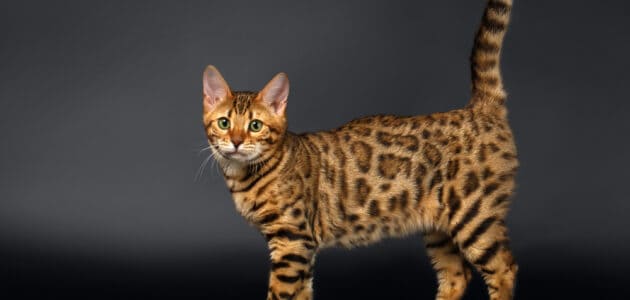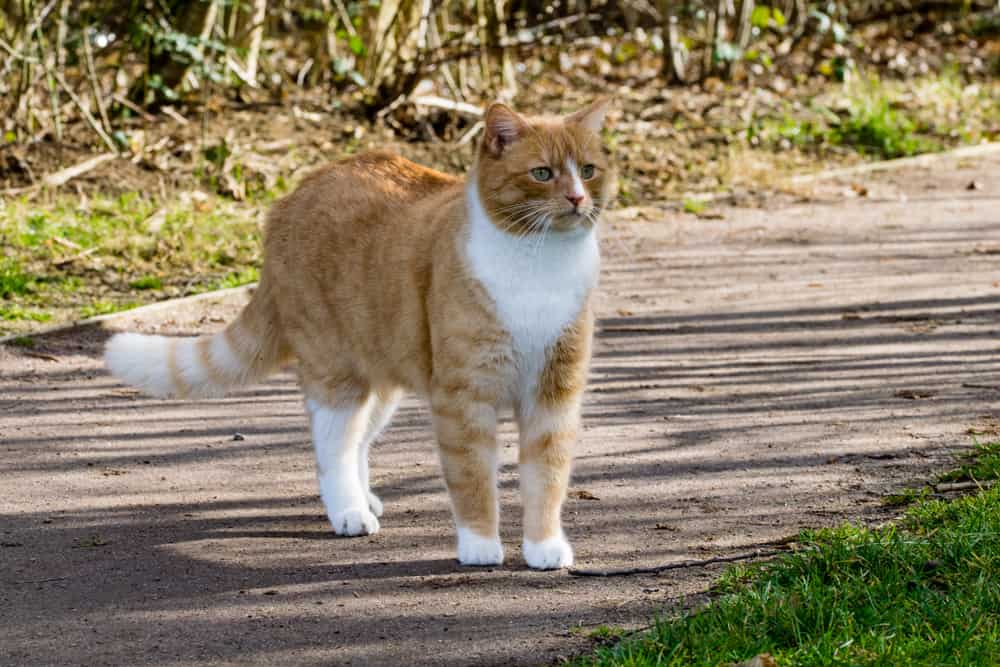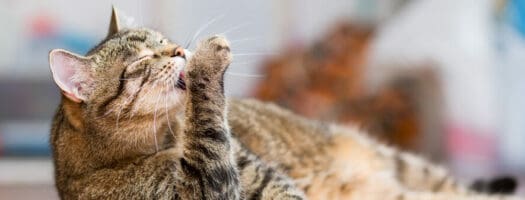Cat Tail Language: What Is Your Pet Trying to Tell You?

Whether you have four cats, you live with a solo feline, or you grew up with a furry friend, you are likely used to the way cats position their tails, and have maybe even noticed that cats seem to use different positions for their tails at different times.
Most of us know that a cat purring and a dog wagging its tail means they are happy, but what about those cat tail movements and positions? Are they random, or do they mean something? Could it be that our cats are actually trying to tell us something with the ways they move and position their tails?
Let’s explore what kitties are communicating through cat tail language.
What Can My Cat Communicate Using Their Tail?
Before we delve into what different movements and positions may mean in cat tail language, let’s first talk about the types of things cats can communicate using their tails. Just like humans, cats use body language to express a variety of emotions. Cats may not have the range of facial expressions that humans have, but they do have a very useful tool: their tails!
Cats use their tails to indicate how they are feeling, whether that be scared, excited, happy, anxious, or angry. While it’s true that a cat’s tail is used for their balance, it can also be used to let humans, fellow cats, and other animals know what is going on in the cat’s head.
Why Should I Care What My Cat Is Saying With Their Tail?
But why does that matter? Do you need to bother to interpret the things your cat is doing with their tail? Can it really mean that much? As most of us humans don’t speak “meow,” it can be helpful to learn what your cat is trying to tell you with his or her tail.
When you know how your cat is feeling, you are better equipped to handle their behavior. You will also be able to recognize the motivation behind your cat’s behaviors, and maybe even be able to change those behaviors.
With a better understanding of how your cat feels in a variety of situations, you will be able to build a better relationship with your pet because you will be able to recognize your cat’s likes and dislikes as well as notice when he or she wants some socialization and when they would prefer to be left in peace.
Tail Positions: What Do They Mean and How Do I Respond?
Now that we know that cats can use their tails to communicate, let’s break down exactly what they are trying to say. And once we know what our feline friends are trying to tell us, we can also figure out what to do in response.
For humans, certain gestures have the same meaning each time they are used: a wave means hello or goodbye, a nod means yes, a handshake is a greeting. Similarly, certain tail movements often indicate the same things in cat tail language, across the wide variety of cat breeds.
Here are some of the most common tail positions, what they are most likely to indicate, and how you can respond when you see your cat communicating using these tail positions.
Tail Held High or Upright
When a cat’s tail is upright, he or she is feeling confident. A raised tail also indicates that your cat is willing to socialize, and is probably feeling happy and friendly. To other cats, this position means your cat is approachable.
How Do I Respond?
Now would be a good time for petting or grooming. Remember though, most cats prefer to be pet on and near their heads. If your petting strays too far from your cat’s preferred petting zones, you may see that tail position change.
Tail Is Puffed Up
if your cat’s tail puffs up like a cartoon kitty, stay away! This position is communicating fear. Cats puff up their tails in response to what they perceive as threats in order to make themselves appear bigger.
How Do I Respond?
When your cat’s tail is saying, “I’m afraid,” give him or her some space. While you may want to try to reassure your furry companion, it is best to leave your cat alone when you see their tail in this position, as trying to comfort him or her may only cause more stress.
Tail Is Curved or Hooked
if your cat’s tail looks like a question mark where the bottom is straight and the top is curved or hooked, your cat is feeling playful. This tail position says that your cat wants interaction, and is feeling happy. While similar to an upright tail, this position is slightly different, and may indicate a bit more playfulness.
How Should I Respond?
With interaction! It is a good time to train, play with, or pet your cat when you see that their tail is hooked or curved. Your cat is likely open to interacting with humans or other animals when their tail is in this position.
Tail Is Lowered
a lowered tail typically indicates that your cat is scared or stressed. While some cat breeds hold their tails low naturally, a tail held straight down or tucked between the legs often means fear, and could even mean that your cat is experiencing pain. Be sure to monitor your cat when you see the tail lowered or tucked, in case a vet visit is in order.
How Should I Respond?
This position is another that says “leave me alone.” When you see the tail lowered, give your cat space. Make sure he or she has the ability to remove themselves from the room or situation.
Tail Wrapped Around a Human or Another Animal
Tail wrapping is how your cat expresses his or her affection. Think of tail wrapping like a hug between humans. This tail position means your cat is feeling affectionate and social.
How Should I Respond?
With affection! Pet your cat, talk to him or her in a soothing voice, offer a treat–whatever you do to let your cat know you love them. Wrapping their tail around you (or another human or animal) is how your cat shows affection.
What Do a Cat’s Tail Movements Mean?
We have now talked about the most common positions your cat might use when speaking with his or her tail language, but what about when your cat is moving their tail? Does that mean anything? Of course it does!
In the same way that humans communicate by moving our bodies (waving, nodding, pointing, etc,) an important aspect of cat tail language are the movements your cat makes with his or her tail. While some movements can have similar meanings to some of the static tail positions we’ve discussed, tail movements can also communicate different feelings.
Tail movements also allow your cat to use more tools to communicate with humans and with other animals. And the more meanings you know, the more likely you are to understand what your cat is trying to say. Here are some of the most common ways your cat communicates by moving their tail, what those movements may mean, and how you can respond to those movements.
Swishing Tail From Side to Side
you are likely to see this motion when your cat is focused. Whether on an object like a toy or treat or on another animal, a swishing tail means your cat is focusing on something, and likely to pounce.
While this behavior may stem from your cat’s predatory instincts, it is not necessarily an aggressive behavior. Though the focus is similar to that used by your cat’s ancestors when hunting prey, the swishing tail of your house cat is likely more playful in nature (unless they’ve spotted a mouse).
How Should I Respond?
Unless your cat is focusing on you, this movement does not require a response from you. You are most likely to see this tail movement when your cat is focused on an object or animal, so your best move is to just let him or her be. Your cat may be exploring or just observing, but he or she is engaged with something and you should let them focus on it.
Whipping or Thrashing Tail From Side to Side
if your cat is moving their tail from side to side more quickly, in a whipping or thrashing motion rather than a slow swish, they are giving you a warning. At best, this motion indicates annoyance and irritation. At worst, it can mean fear, anger, and aggression.
How Do I Respond?
If you see this movement, give your kitty some space and time to calm down or retreat from the situation. You can try talking to kitty in soothing tones, but it would not be a good time to try to pet him or her. Perhaps take note of what could be upsetting your pet, but do not try to touch him or her.

Remember, Every Cat Is Different
Please note that also like humans, each cat is an individual and will have unique quirks and behaviors that may not fit the general interpretations listed here. Before trying to use the information you have just read to decode your cat’s communication, make sure to take a little time to observe your cat’s specific habits.
You may find that sometimes your cat uses one tail position to communicate two different moods, or that maybe he or she doesn’t use a certain position at all. That’s okay! Use the positions and meanings here as a general guide, and make note of your cat’s specific communication habits.
You know your cat better than anyone, so you are the best judge of what his or her communication looks like.
Listen to What Your Cat’s Tail Is Trying to Say
Whether you realize it or not, cats can say a lot without any words (even if you swear your cat really is meowing, “No,” or “I love you,” or “Please don’t make me wear that sweater again, Gina.”) When you take a moment to look at the positions your cat holds their tail and the ways in which they move it, you may realize that your cat is talking to you after all.
With this guide in hand, you’ll now know when your kitty will tolerate cuddles and when they are more likely to claw their way out of your arms. You’ll also be able to tell right away if the new couch really scares the cat or not, as well as how he or she feels about your bearded dragon.
May your newfound knowledge help you to really understand your cat, and maybe even help them understand you, too.




